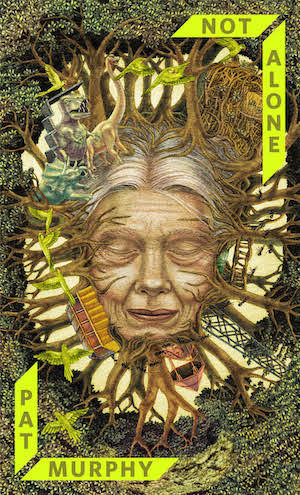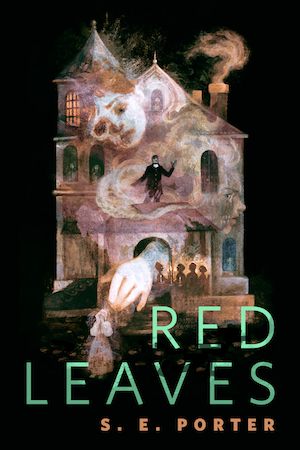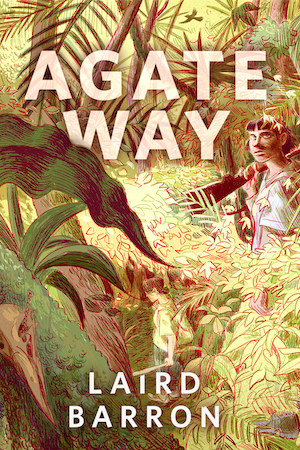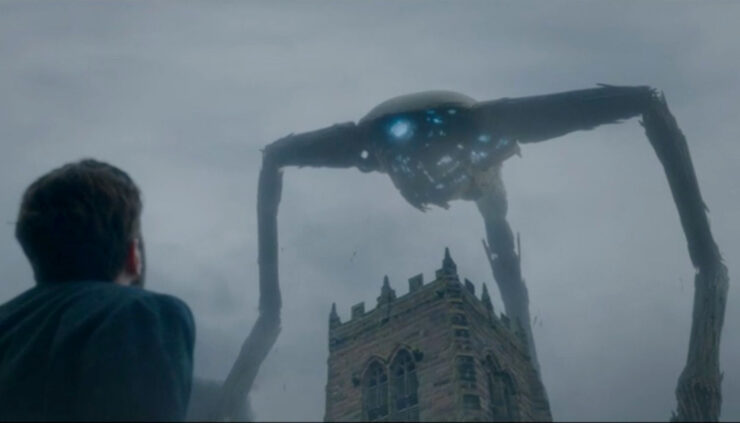Could it be that every generation gets The War of the Worlds it deserves? You might think so if you scanned the results of an IMDB search, as I did. Not counting obvious sequels and a “musical drama,” there are at least ten feature and TV adaptations of H.G. Wells’ 1895 novel, all taking on the book with varying degrees of fidelity. That would be one adaptation approximately every thirteen years if they were spread out evenly over time. Of course, it’s actually back-weighted from the middle of the twentieth century forward, with something of a boom in the last 24 years. And that’s before the property entered the public domain this year—I can’t wait for the version that’ll pit a highly-armed Winnie the Pooh against Martian Steamboat Willie.
It was a bit of a dilemma for me. I had pitched this piece as a look at George Pal’s classic, 1953 adaptation, taking in for good measure Orson Welles’ notorious radio broadcast, and Stephen Spielberg’s blockbuster remake. But the roster of additional versions nagged at me—I was tempted to sift through all of them, to see what they may or may not have brought to the table. But I had neither the time nor, frankly, the inclination to subject myself to a real-life replication of Groundhog Day with Martian war machines, so I resolved to stick to my original plan.
With one exception: A 2019, British “limited series” (remember when we used to call them miniseries?) starring Eleanor Tomlinson and Rafe Spall. All adaptations take liberties with Wells’ original text, of necessity, but this one, written by Peter Harness, went quite a bit further. It drew the background of its protagonists—George (Spall) and Amy (Tomlinson)—from Wells’ actual life, and divided the story into two, interleaving narratives: Going from the original invasion to the Martians’ fall; and picking up five years hence, when Amy and her young son, born after the invasion, struggle to survive in an Earth that’s dying, and where what’s left of government and religion have rewritten the narrative to claim a rousing victory for God and Empire.
But what really caught my attention was that it was being presented as a period piece, set at the dawn of the twentieth century, a few years after the time of the original novel. That piqued my curiosity: When I had first read Wells’ novel, as an adolescent and after having been exposed to both the Welles and Pal adaptations, I was left wondering why neither of those attempts were faithful to the original’s setting. There was something very intimate in Wells’ telling, delivered from the viewpoint of a well-educated but otherwise ordinary man, dealing with horrific circumstances. He managed to convey a certain society, a culture, a world, in a way that felt intimately palpable, more so than Welles’ radio dispatches or Pal’s effects-laden spectacular.
Watching this series, though, I began to question my original impression. The show was fine in itself, a bit grimmer than we might usually expect (the story resolves with just the barest glimmer of hope); featuring a bit more melodrama than I felt was necessary (but which is pretty much part of British serialized storytelling); and offering a production that is quite impressive in its invasion parts, but that smelled of stretched budget during its post-apocalyptic sequences. Overall, Harness and director Craig Viveiros managed to fulfill their own, unique vision, while remaining faithful to Wells’ original intent of throwing British Imperialism back in the Empire’s face.
But, weirdly, in making the story period-appropriate, something had gone out of the telling. An immediacy…a feeling that this was a thing that could happen to me. It turned out that the power of Wells’ novel was not in the timeframe, but in the perspective, written in the first person, letting us see the nightmare through the eyes of the man living it. It’s a weary cliché, but a relevant one: Most frequently, science fiction isn’t really about the future, and horror isn’t about the supernatural. It’s about what we’re dealing with today, about our hopes and our fears right now. Maybe because Wells was the first to imagine our world laid asunder by forces more advanced than ours, The War of the Worlds became not just a specific story, but a template, one that creators could mold to measure how far society had advanced, and how much further it needed to go.
Orson Welles saw not only how his time—with a world precariously teetering on the brink of war—could reshape Wells’ narrative, but also how the medium used to convey the tale could be leveraged (maybe “subverted” is the better word) to amplify its impact. The Mercury Theatre on the Air radio broadcast of The War of the Worlds (1938) eschewed in its first act the typical narrative structure, instead presenting its story as a series of live news bulletins cutting into a band concert (poor Ramón Raquello—never got to finish a number). A lot has been exaggerated about the reaction of the broadcast’s audience that Halloween eve—among other myths, it doesn’t appear anyone actually committed suicide. But by the time the show reached its more conventional second act—presented as narration culled from the notes of the respected Professor Richard Pierson (Welles) as he struggles to survive in the aftermath—people were panicked enough to trigger calls for an FCC investigation, and to prompt an apology from Welles himself.
Listening to the broadcast now, what’s most striking is the realization that civilization has been in a desperate game of catch-up with communication technologies since long before the advent of the internet. Those who were listening—and especially those who made the mistake of tuning into the show after Welles’ opening narration set up the scenario (again, the number of people who fell victim to this seems to have been inflated over time) —were still acclimating to a medium yet in its infancy, so much so that they failed to notice how shockingly time-compressed everything was, as it was being conveyed. Characters were travelling scores of miles in mere minutes, and an army rallies to the invasion site at Grovers Mill, New Jersey almost instantly. Neither did people notice that their regular ol’ receiver had suddenly attained the ability to relay radio reports from Army flyovers, and desperate communications from ham radio operators, all without ever having to be retuned. (But that lone voice croaking out, “2X2L calling CQ… 2X2L calling CQ…” may be radio’s most chilling lead into an act break.) Nor did a number of listeners think to JUST TUNE TO ANOTHER STATION to see if anyone else was covering this breaking news.
I don’t know how much Welles was counting on a contemporary audience’s tendency to wander around the dial until they tuned in to something interesting (the birth of the doom scroll?). He at the very least sensed the public’s vulnerability at a time when, suddenly, the world was pouring into their living rooms. Twenty-something scamp that he was, Welles knew how to take advantage of their receptiveness, to put it mildly. (BTW, let’s all keep an eagle-eye out for deepfakes this election season, people.)
Flash-forward some seven decades, and we discover another master of his medium, Steven Spielberg, turning his own formidable skills to a mega-budgeted, big screen interpretation of the tale. Aside from being bigger, louder, and more technologically sophisticated than either the Welles or the Pal interpretations, the 2005 rendition of The War of Worlds separated itself by one notable, but more subtle distinction: Instead of giving us a scholarly scientist as a protagonist, Spielberg returned the viewpoint back to Wells’ grounded level, making the audience surrogate, Ray Ferrier, a down-to-earth blue-collar worker. A hunky, preternaturally handsome, and astoundingly capable blue-collar worker, mind—played by Tom Cruise—but one most audience members wouldn’t have been surprised to find sharing a row with them in the theater.
But it was now a century removed from Wells’ society, and Spielberg being Spielberg, the whole canvas of his War takes an especially personal turn. Unlike his predecessors, Ray is a notably flawed hero, a divorced dad struggling through a weekend visitation with his two children—young daughter Rachel (Dakota Fanning, in a stunning performance) and sullen teen son Robbie (Justin Chatwin). And Ray is an especially bad divorced dad, showing up late for the drop-off, forgetting to prep for his guests, and most unnervingly, failing to pick up the cues from his terrified daughter as he presses her to sit back and enjoy the cool light show taking place over their home, the one that just so happens to auger the Martians’ arrival.
This is, after all, the twenty-first century, and in the twenty-first century—as Spielberg, one of the prime instigators of the trope, has repeatedly pointed out—it’s not just about spectacle, it’s about family. And so, in the director’s telling, Ray will grow as a father, learning to should the responsibility of protecting one young life even as he matures enough to understand why another needs to go his own way. That Spielberg is able to mount a tale of personal growth within a mammoth panorama of global destruction again demonstrates his virtuosity. The fact that, while watching, I was left occasionally wishing he wasn’t quite the virtuoso may say something about how his filmmaking prowess has occasionally exceeded his audience’s capacity to appreciate it.
The Spielberg who shows up for War of the Worlds is the one who, as with Saving Private Ryan and Schindler’s List, wanted not just to make filmgoing an immersive experience, but immerse us in experiences we’d otherwise prefer to skip over. I have no issue with the idea that art—to quote Cesar A. Cruz—should disturb the comfortable, and God knows that we in the US occasionally need to be reminded that we enjoy a comfort that those in more besieged portions of the world can only dream of. But in replicating so accurately the unremitting horror of war landing at one’s doorstep, while presenting it in the format of a big-budget special effects spectacular, the director’s message maybe gets pushed so hard that it exceeds the point of exhaustion. Spielberg’s take is ambitious, smart, and notably respectful to the purpose Wells thought his tales should serve, but for me it was also an eye-popping, compulsive, and ultimately—and unfortunately—unpleasant experience.
It could be that George Pal intended his own The War of the Worlds (1953) to be just as unsettling—I’ve spoken to a few people who were just the right, tender age to be traumatized by his rendition. He would have had motivation: The US hadn’t crossed the decade threshold from its victory in WWII; the Korean War was still ongoing and largely unpopular; the specter of the A-bomb still loomed over everything; and the Hungarian-born Pal, having emigrated from Europe to the US in 1939, likely held at best an ambivalent view of modern warfare. But if that was the message, it wound up a bit muddled.
The film, directed by Byron Haskin, plays frequently like a standard wartime flick, with the military given respectful due as they determinedly go about trying to fend off the Martian menace, and considerable screentime gets devoted to stock footage of the United States’ mechanized power—the prototype YB-49 Flying Wing is featured so prominently that one hopes Northrop was paying Pal handsomely for the product placement. But you still get the sense that Pal and Haskin aren’t all-in on Cold War militarism: The Martian war machines still manage to run roughshod over our armed forces, and given the A-bomb’s ineffectuality here (and Pal’s subsequent The Time Machine’s grim vision of nuclear war and its aftermath), it’s clear that producer and director weren’t trying to sell us on the idea that Might always makes Right.
If only they had been similarly progressive in how they portrayed their characters. Gene Barry cuts a fine, masculine presence as all-purpose scientist Dr. Clayton Forrester (for all you MST3K fans who weren’t aware, surprise!), but the furthest he gets out of hero mode is when a crowd of rioters, seeking to commandeer his truck, kick his ass. As requisite romantic interest Sylvia Van Buren, Ann Robinson has a more thankless task, oscillating her attitude from domestic complacency—her greatest moment of agency comes while serving coffee to a group of soldiers—to screaming hysterics. As for the film’s resident “Latino,” Salvatore… Well… Look, it’s not Jack Kruschen’s fault. At least the character’s treated as an equal among his peers.
The film overall displays a whipsaw, emotional dichotomy—perhaps an outcome of its ninety-minute runtime, or just a tendency of filmmakers at the time to lean into well-worn narrative tropes. Sylvia’s uncle, Pastor Collins (Lewis Martin), encourages his niece to pursue Dr. Forrester—having spent all of several hours with the man—right before he himself is vaporized by a Martian death ray. When Sylvia and Clay are forced to shelter in a fifties-cozy farmhouse, we get an incongruous scene of domestic bliss—with Clay complimenting Sylvia on her knack for frying up (pyyuch!) eggs sunny-side—that’s rudely interrupted when a plummeting Martian cylinder reduces the joint to rubble. I’d like to think Haskin was slipping a fast one past the suits in that moment; among his subsequent works would be The Outer Limits’ “Demon with a Glass Hand,” so turning a skeptical eye toward the postwar dream of a consumerist paradise doesn’t feel too out of character for the director.
What I am sure of is that, for all Pal’s War brands itself as very much a tale of its time, it’s also earned its classic status. It is a landmark sci-fi (yes, I said sci-fi) thriller, one that invited audiences to revel at the wholesale destruction of the world while they wolfed down fistfuls of popcorn. The special effects remain a cinematic milestone—Spielberg may have brought an insane level of detail (and actual legs) to his CG war machines, but Pal’s ominously floating, manta-like metal monsters, surmounted with fire-spitting, python-shaped armaments, cast a terrifyingly beautiful vision of alien death, one that lodges in the memory long after viewing. And while Spielberg may have paid homage to Pal in numerous ways—turning, among others, the moment when the protagonists are chased through a house by a Martian periscope into a beautifully choreographed tour-de-force—there’s something about the tangible simplicity of Pal’s practical effects that leaves a more indelible impression. In 2005, we got a full-on look at a disease-ridden and dying Martian emerging from its crashed war machine, but it’s the 1953 sight of just a spindly, withered Martian hand feebly reaching out from an escape hatch that continues to haunt.
If the milieu of Pal’s The War of the Worlds remains stuck in the clichés of its time—I’m not sure Wells would’ve appreciated the peal of church bells that ushers the film out, taking the whole “God in his wisdom” notion a bit too much to heart—its portrait of a nation still trying to reconcile its recent ascension to a position at the top of the world order remains compelling.
It’s kind of amazing, the ball that H.G. Wells got rolling in 1895 and that proceeded to spin its way far and wide into our culture. The influence of The War of the Worlds extends far beyond the story itself, touching everything from Earth vs. the Flying Saucers to Mars Attacks! to Independence Day to Plan 9 from Outer Space. Yet the original tale—with its stark warning about how we see ourselves and how that vision might fracture in the face of superior forces—sets it apart, and the way Wells’ told it has inspired filmmakers across the years to tailor it to their times. I don’t doubt we’ll see more versions in the coming years. If we do, I look forward to discovering how they’ll cast new insights into the world we live in, and what we must do to assure that humanity not just survives, but thrives.
The original intent for this piece was to go back to George Pal’s original adaptation, and while I was caught a little off guard by how some of the dramatics had aged, I was overall gratified to reintroduce myself to one of SF filmmaking’s classic efforts. But what do you think? Did I judge any of the versions cited here too harshly? Are there others you would recommend (or warn against)? The stage is set for you in the comments section below. I welcome your feedback, so long as it’s friendly and polite.










